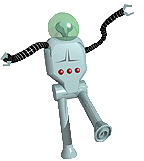
|
|

|
|
|
These are the rules for the Navigation Contest Events held on 1 April, 2000 as amended and approved by the membership at the January, 2000 SDRS meeting. San Diego Robotics
Society Navigation Contest.
Rules: (NOTE: All terms in quotes have specific meanings or dimensions that are described in detail later in the rules.) The navigation contest is divided into three separate events. 1. Basic Navigation Event: Robots will be required to start in a "Starting Block", near the bottom center of the rectangular "Playing Field". There will be four obstacles placed at the four corners of the "Inner Rectangle". Each robot must traverse an approximate rectangular path by passing to the outside of all four obstacles, while staying inside the "Playing Field", and return to the "Starting Point". Robots will have five minutes to complete each run. Time permitting, multiple runs will be scheduled. 2. Complex Navigation
Event: Same "Playing Field" as the Basic Navigation Event above. Robots
will be required to circle each obstacle in the order selected by random
drawing, and return to the "Starting Point". The order for passing obstacles
will be made available to all
3. Mine Clearing"
Event: The "Inner Rectangle" for the two events above will not apply to
this event. In the upper two thirds of the playing area, eight to ten coin
shaped objects will be placed at random. They will all look similar, however
most of them will be inert dummies (non-magnetic), and three of them will
be "mines" or magnets. Robots will have ten minutes to discover and "mark"
as many mines as possible.
Calibration Period: Ten minutes before each of these events there will be an announced calibration period. This is the time for participants to make any adjustments, light readings or any other calibrations desired due to existing or changing ambient light or other conditions. Starting Order: Robot starting order will be chosen by random drawing. The dimensions of the playing field will be the same for all contests. Any minor differences in the playing field layouts will be described below. There will be two classes for each event. Totally Autonomous Class: Robots in this class must have all processing on board. There can be no external processors, beacons (described below) or telemetry between the robot and any device external to the robot. Externally Autonomous
Class: Robots in this class may communicate with outside equipment or processors
through any wireless means. The outside processor, must however be autonomous
in itself, i.e. it cannot be
Robot Specifications: Size: There are no size restrictions. Weight: There are no weight restrictions. Power: Robots must have self contained, quiet, non-polluting power sources. BEACONS:
Beacon Placement
Area: All beacons must be placed in one of, BUT NOT BOTH, of the following
configurations:
PLAYING FIELD: The playing field
is a 22 X 30 foot rectangle, on a flat linoleum floor, with the North and
South sides being the 22 foot dimension. "North" as used here is an approximate
direction, not an exact North. One foot
Using X, Y coordinates, the parts of the playing field are: Outside Boundary: (One foot high wall) 24 X 32 feet ____________X__Y
Outside Playing Field Boundary: 22 X 30 feet ____________X
Y
Inner Rectangle:
12 X 10 feet. (Imaginary; not drawn on playing floor. Four obstacles (4"
X 4" X 5" wooden blocks) will be placed at the corners.)
Starting Block
(Marked with tape):
Starting Point
(Small dot on the floor):
The room containing
the playing field is an approximately 30 X 40 foot room with six-foot high
windows from waist high up, along the East wall. The room has tenet ceilings
with standard 4 foot long 40 watt fluorescent bulbs, three per receptacle,
spaced at about six feet. The windows have blinds that can be drawn, and
they will be drawn for the events, however they are not "light tight" and
there is no guarantee
DETERMINING FINISH ORDER OF ROBOTS: Basic Navigation
Event and Complex Navigation Event:
At the end of
each run, when the robot stops, or when time runs out, the judges will
measure the distance from the bottom of the robot pointer to the "Starting
Point". That distance (in inches) shall be the score for
"Mine Clearing"
Event:
0-420 points...Points for time for each run shall be given at one point per second, up to a maximum of seven minutes, or 420 points. -200 points.....Locating and marking all three mines and returning to the "Starting Block" in under seven minutes. -100 points.....For each mine located and marked. 10 points........One or more robot wheels or legs touch the outside boundary line of the playing field. 100 points.......Robot completely exits the playing field. (All parts of the robot that normally touch the ground while the robot is moving are outside the playing field.) 200 points.......Robot wheel runs over a "mine". Judges: One or more judges will be assigned for each event. Judges may not participate in any event in which they are participants. Judges decisions are final. |
This page was last updated on Apr. 25, 2000